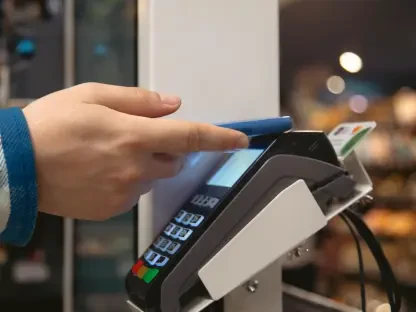The retail industry stands on the brink of a transformative era, where artificial intelligence (AI) is not just an add-on but a core driver of shopping experiences. Imagine walking into a store where cameras instantly analyze your preferences, or clicking a button during a TV show to buy a featured product in real time. As of now, retailers are harnessing AI, shoppable TV, and video analytics to create seamless bridges between physical and digital realms. This report delves into how these technologies are reshaping customer engagement and operational efficiency, setting a new standard for the industry.
The Current Landscape of Retail Technology in 2025
Retail technology has reached unprecedented heights, with AI becoming a cornerstone for innovation across the sector. Major players like Walmart, Amazon, and Target are investing heavily in tools that merge online and in-store experiences, ensuring customers encounter personalized interactions at every touchpoint. Smaller boutique retailers are not far behind, leveraging scalable tech solutions to compete in a crowded market, often focusing on niche customer engagement strategies.
A significant trend is the rise of shoppable TV, where partnerships with streaming platforms enable instant purchases during broadcasts. Video analytics, meanwhile, empowers retailers to optimize store layouts and inventory by tracking consumer behavior in real time. These advancements are not merely about convenience but about redefining how shopping integrates into daily life, blending entertainment with commerce.
Key industry leaders are prioritizing both customer satisfaction and operational gains. Walmart and Amazon are spearheading large-scale tech integrations, while Target focuses on in-store AI applications to enhance service delivery. This collective push toward tech-driven retail signals a broader shift, where efficiency and engagement are no longer separate goals but intertwined outcomes of strategic innovation.
Key Innovations Driving Retail Transformation
Emerging Tools and Consumer Trends
Shoppable TV streaming has emerged as a game-changer, with retailers like Walmart collaborating with platforms such as Roku to facilitate real-time purchases during shows. This trend capitalizes on younger consumers’ inclination to blend entertainment with shopping, creating a fluid experience where a click on a remote translates to a delivered product. Such integrations are redefining e-commerce by embedding it into passive viewing moments.
AI-powered video analytics is another pivotal innovation, transforming in-store operations for giants like Amazon and Best Buy. These tools monitor foot traffic and customer interactions, enabling dynamic pricing strategies to counter inflated costs and offer competitive deals. Beyond pricing, the technology helps retailers understand shopper emotions and preferences, tailoring layouts and promotions accordingly.
Consumer behavior continues to evolve, with a growing expectation for seamless, affordable experiences across channels. Younger demographics, in particular, demand affordability alongside entertainment-driven shopping, pushing retailers to adopt interactive tools. This shift underscores a broader cultural move toward integrated commerce, where technology must anticipate needs before they are even articulated.
Market Impact and Growth Projections
The impact of these innovations is measurable, with Nielsen forecasting that shoppable TV could contribute to 15% of e-commerce sales by the end of this year. This projection highlights the rapid adoption of interactive media as a sales channel, particularly among digitally native consumers. Retailers embracing this trend are already seeing significant boosts in conversion rates compared to traditional online advertising.
Performance metrics further illustrate the value of AI tools, with video analytics reducing stockouts by 25% through real-time demand insights. Additionally, Incisiv reports a 30% improvement in loss prevention, as cameras and algorithms detect theft and inefficiencies more effectively. These figures underscore how technology is not just enhancing sales but fortifying operational resilience.
Looking ahead, AI chatbots are expected to replace traditional search methods for 60% of shoppers by mid-year. This shift points to a future where conversational interfaces dominate product discovery, further personalizing the shopping journey. Retailers must prepare for this transition, ensuring their digital platforms are equipped to handle such interactive, intuitive engagements.
Challenges in Adopting AI and Retail Tech
The adoption of AI and advanced retail technologies is not without hurdles, with privacy concerns topping the list. Video analytics, while powerful, raises questions about data collection and consumer consent, as shoppers remain wary of being monitored. Retailers must navigate these sensitivities carefully to maintain trust while leveraging the benefits of behavioral insights.
Operational challenges also loom large, particularly in workforce adaptation and infrastructure readiness. Employees need training to use sophisticated tools like analytics dashboards, while systems must be agile enough to support innovations such as mixed reality. Balancing personalization with data security adds another layer of complexity, as breaches can erode customer confidence overnight.
To mitigate these risks, strategies like anonymized data processing are gaining traction, ensuring insights are gathered without compromising individual identities. Robust cybersecurity measures are equally critical, protecting both retailer and consumer interests. Addressing these challenges head-on is essential for sustained tech integration, allowing innovation to flourish without unintended consequences.
Regulatory and Ethical Considerations in Retail Tech
The regulatory landscape for AI and data use in retail is increasingly stringent, with privacy laws shaping how technologies are deployed. Compliance with these mandates is non-negotiable, as violations can lead to hefty fines and reputational damage. Retailers must stay abreast of evolving regulations to ensure their tech initiatives align with legal standards.
Innovations in anonymized data processing, led by companies like Verkada, offer a path forward by minimizing privacy risks. These solutions allow retailers to harness video analytics and other tools while adhering to consumer protection norms. Such advancements are vital in addressing public concerns and fostering a culture of responsible data use within the industry.
Ethical considerations, particularly around dynamic pricing, also demand attention. Transparency initiatives, such as Kroger’s blockchain technology for perishables pricing, help build trust by clarifying cost structures to shoppers. Retailers must prioritize clear communication about pricing algorithms and data practices, ensuring ethical standards keep pace with technological progress.
The Future of AI in Retail: Trends and Predictions
Looking toward the horizon, retail technology is poised for further evolution with tools like augmented reality try-ons gaining prominence. These innovations, alongside mixed reality, are expected to complement shoppable streaming, offering immersive experiences that blur the lines between virtual and physical shopping. Such developments promise to deepen customer engagement in novel ways.
Consumer demand for affordability remains a potential disruptor, pushing retailers to refine omnichannel strategies that sustain loyalty across platforms. Economic factors, including tariffs and global market fluctuations, add uncertainty, necessitating data-driven resilience. Retailers must leverage AI insights to anticipate shifts and maintain competitive pricing amid external pressures.
The trajectory of AI in retail also hinges on scalability and adaptability, as smaller players seek to match the tech prowess of industry giants. Emerging tools will likely prioritize accessibility, enabling broader adoption across diverse retail segments. As these trends unfold, the ability to integrate innovation with consumer-centric values will define market leaders in the coming years.
Conclusion: Navigating Retail’s Tech-Driven Evolution
Reflecting on the transformative journey of retail in recent times, it is evident that AI, shoppable TV, and video analytics have redefined both operations and customer engagement. These technologies have delivered remarkable gains in sales and efficiency, yet they also bring to light persistent challenges like privacy concerns and infrastructure demands. The path retailers have carved out shows a delicate balance between embracing innovation and safeguarding trust.
Moving forward, the industry should focus on actionable strategies to sustain this momentum. Prioritizing transparent data practices and investing in scalable, secure systems could address lingering risks while amplifying tech benefits. Additionally, fostering partnerships across platforms and sectors might unlock new avenues for growth, ensuring retail remains agile in an ever-shifting landscape. Adaptability, above all, emerges as the linchpin for enduring success in this tech-centric era.









